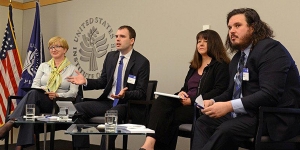Cultural Heritage: A Target in War, an Engine of Peace
In 2001, Taliban fighters dynamited Afghanistan’s massive Bamiyan Buddha statues, carved into cliff faces, into rubble. Serb forces burned Bosnia-Herzegovina’s Sarajevo National Library in 1992 and ISIS extremists recently razed ancient temples in Palmyra, Syria. Such deliberate destruction of cultural heritage is so damaging to civilizations that the world recognizes it as a war crime. But the power of cultural heritage, so targeted in war, also can provide instruments to build peace. An October 24 symposium in collaboration with the Smithsonian Institution will use recent experience, notably in Afghanistan, to examine the often unrecognized power of cultural heritage. The discussion will explore new ways that it might serve worldwide to prevent, or recover from, violent conflict.
Read the event coverage, Can Afghanistan Write New Future in Calligraphy?
Recent wars offer no greater example of cultural heritage turned to healing than the work in Afghanistan of the charity Turquoise Mountain, the subject of a stunning, 11-month exhibition by the Smithsonian Institution. “Turquoise Mountain: Artists Transforming Afghanistan,” at the Arthur M. Sackler Gallery, shows how historians, artisans, young students and communities are preserving and renewing traditions, crafts, economic livelihoods and a historic district of Kabul. This symposium at the U.S.
The agenda is now available.
8:45 - Registration and Coffee in the atrium
9:15 - Welcome: Nancy Lindborg, President, USIP
9:20-9:25 - Hila Alam, Minister Counsellor, Embassy of the Islamic Republic of Afghanistan, Washington D.C.
9:25-9:35 - William Hammink, Assistant to the Administrator, Office of Afghanistan and Pakistan Affairs, USAID
9:35-9:45 - Mark Taplin, Principal Deputy Assistant Secretary, Bureau Of Educational and Cultural Affairs, U.S. Department of State
9:45-10:45 Panel 1: What is Cultural Heritage and (Why) Does it Matter?
Moderator: Molly Fannon, Director, Office of International Relations and Global Programs, Smithsonian Institution
- Dr. Julian Raby, Dame Jillian Sackler Director, Arthur M. Sackler Gallery and the Freer Gallery of Art
- Dr. Derek Gillman, Distinguished Teaching Professor, Art History and Museum Leadership, Drexel University
10:45-11:00 Break
11:00-12:15 Panel 2: Looking Back: 15 Years of Cultural Heritage Initiatives in Afghanistan
Moderator: Barmak Pazhwak, Senior Program Officer, Asia Center, USIP
- Dr. Tommy Wide, Assistant Director of Special Projects, Freer and Sackler Galleries
- Majeed Qarar, Cultural Attaché, Embassy of the Islamic Republic of Afghanistan, Washington D.C.
- Jolyon Leslie, Architect
- Laura Tedesco, Cultural Heritage Program Manager, U.S. Department of State
12:15-1:15 Lunch
Calligraphy demonstration in the atrium with Sughra Hussainy, visiting Turquoise Mountain artist
Portal Installation
1:15-2:30 Panel 3: Looking to the Future: New Generation, New Technology, New Approaches
Moderator: Scott Liddle, Country Director, Turquoise Mountain Afghanistan
- Amar Bakshi, Founder and CEO, Shared_Studios
- Adam Lowe, Director, Factum Arte
- Dr. Bastien Varoutsikos, Research Fellow, Centre national de la recherché scientifique (CNRS), Paris
- Lina Rozbih, Managing Editor, Ashna TV, Voice of America
2:30-2:45 Tea and Coffee
2:45-4:15 Panel 4: Looking Out: Comparisons, Lessons, Inspirations
Moderator: Katherine Wood, Senior Arts Adviser, USIP
- Harry Wardill, Director, Turquoise Mountain Myanmar
- Corine Wegener, Cultural Heritage Preservation Office, Smithsonian Institution
- Tess Davis, Executive Director, The Antiquities Coalition
- Joanna Sherman, Founder and Artistic Director, Bond Street Theater
4:15 Closing remarks: Richard Kurin, Acting Provost and Under Secretary for Museums and Research, Smithsonian Institution
4:30 Reception





